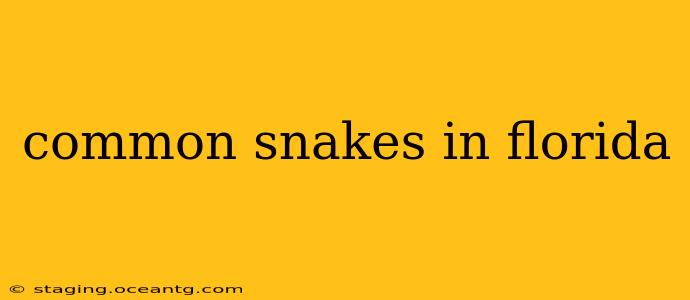Florida's diverse ecosystem boasts a wide variety of snakes, from the harmless corn snake to the venomous eastern diamondback rattlesnake. Understanding which snakes are common in the Sunshine State is crucial for safety and appreciating the natural world. This guide explores some of the most frequently encountered species, providing identification tips and crucial information on their behavior and potential dangers.
What are some common non-venomous snakes in Florida?
Florida is home to many non-venomous snakes, often mistaken for venomous ones due to similar coloration or patterns. These harmless residents play vital roles in the ecosystem, controlling rodent populations and contributing to the balance of nature. Some of the most common include:
-
Corn Snakes (Pantherophis guttatus): These beautiful snakes are easily identifiable by their distinctive red, black, and yellow markings. They're docile and make popular pets. They're often found in fields, meadows, and near human habitation.
-
Black Rat Snakes (Pantherophis obsoletus): As their name suggests, these snakes are predominantly black, though juveniles may exhibit some pattern. They're excellent climbers and often found in trees and around buildings. They're known for their agile hunting of rodents.
-
Eastern Garter Snakes (Thamnophis sirtalis): These slender snakes have variable coloration, often featuring three longitudinal stripes. They're commonly found near water sources and feed on amphibians and small fish.
-
Brown Snakes (Storeria dekayi): These small, secretive snakes are usually brown or gray and are often found under rocks, logs, and leaf litter. They are rarely seen and are harmless to humans.
-
Southern Black Racers (Coluber constrictor priapus): These fast-moving, slender snakes are typically dark-colored. While they can be intimidating in size and speed, they are non-venomous and mostly eat rodents and other small animals.
What are some common venomous snakes in Florida?
While the majority of snakes in Florida are harmless, several venomous species reside within its borders. Understanding their identification is vital for safety. Never attempt to handle a snake you suspect might be venomous.
-
Eastern Diamondback Rattlesnake (Crotalus adamanteus): This is the largest venomous snake in North America and easily identified by its large, diamond-shaped markings and prominent rattle. It prefers sandy or flatwoods habitats.
-
Cottonmouth (Agkistrodon piscivorus): Also known as water moccasins, these snakes have a distinctive dark, almost black, band around their mouth. They are frequently found near water. They're ambush predators, often remaining still until striking.
-
Copperhead (Agkistrodon contortrix): Copperheads possess a distinctive reddish-brown hourglass-shaped pattern on their back. They are often found in wooded areas and rocky outcrops.
-
Coral Snake (Micrurus fulvius): Easily confused with other non-venomous snakes, coral snakes have bright red, yellow, and black bands. The saying "red on yellow, kill a fellow; red on black, venom lack" is a helpful (though not foolproof) mnemonic device for identification. However, always err on the side of caution and assume any snake with red, black, and yellow banding is venomous.
How can I identify snakes in Florida?
Snake identification can be challenging, even for experts. Several factors can influence coloration and patterning, making definitive identification from a distance difficult. The best approach is to:
- Observe from a safe distance: Never approach or handle a snake.
- Note key features: Pay attention to size, color patterns, head shape, and body shape.
- Consider the habitat: Where was the snake located? This can help narrow down possibilities.
- Use a field guide or online resources: Many reliable resources can aid in identification, but always use multiple sources to confirm.
- Contact a wildlife expert if unsure: If you're unsure of a snake's identification, contact a local wildlife agency or herpetologist for assistance.
What should I do if I encounter a snake in Florida?
The best course of action when encountering a snake is to leave it alone. Give it space and allow it to move away on its own. Avoid sudden movements or attempts to handle or kill it. If you are bitten by a venomous snake, seek immediate medical attention.
Are there any resources for learning more about Florida snakes?
Yes! Several organizations and websites offer detailed information about Florida's snake fauna. A quick online search for "Florida snake identification" will yield numerous results. Local universities and nature centers often have educational resources available as well.
How common are snakebites in Florida?
While Florida has venomous snakes, snakebites are relatively uncommon. Most bites occur when people try to handle or kill a snake. By maintaining a safe distance and respecting their space, you can significantly reduce the risk of a snakebite.
Remember, respecting wildlife is crucial for both your safety and the preservation of Florida's rich biodiversity. Learning to identify and appreciate these creatures contributes to a safer and more enriching experience in the Sunshine State.
